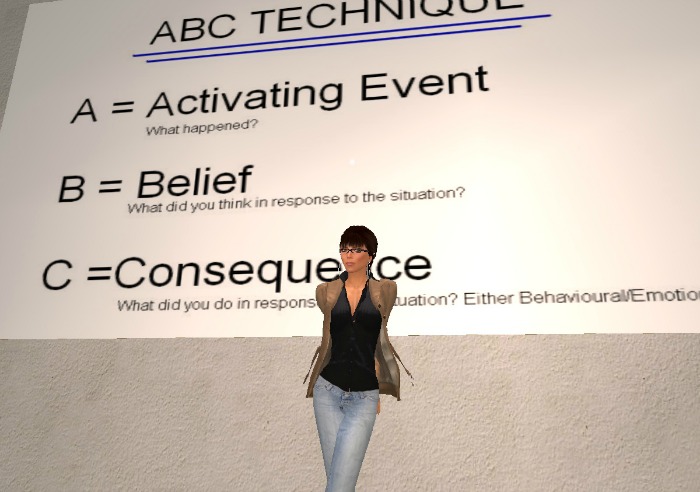Virtual Reality: Therapy’s New Office?
This week, I have the pleasure of introducing Kylie Coulter to you. For most therapists, online therapy is a rather new and/or unexplored terrain. This is not the case for Kylie; she has actually been working as an online therapist for the past five years.
Kylie conducts therapy via video conferencing, voice conferencing or texting using different chat programs. In addition, she provides counseling via her avatar Emota in Second Life (SL), the modality of virtual reality (VR). Kylie has three years of experience in the VR world.
Some of you may already know Kylie from her blog Online Counselling or her website Life Choices.
Kylie Coulter
Without further ado, Kylie, what made you decide to pursue a diploma in counseling/ bachelor’s degree in psychological science?
When I was 16, I developed an interest in psychology and philosophy and after taking a career test in high school it was discovered that counseling/psychology or forensic psychology would be a good career choice for me. After pursuing a career in sales, which I found very unfulfilling, I decided to do a course in counseling.
By the age of 19, I was studying counseling and after finishing my counseling diploma, I decided I wanted to take my education as far as I could, so I applied for entry into The University of New England, N.S.W, Australia.
Next year I will be 26 and completing my honors year. I’ve found I have a moderate aptitude for psychology and have therefore set my sights on, eventually, a PhD. I would like to specialize in applying therapeutic interventions online.
What made you decide to try online therapy and how did you first go about doing it?
After attaining a counseling diploma in 2007, I discovered the internet as a vehicle for therapeutic interventions and began providing free counseling to anyone who wanted it—sourcing client’s mainly through Myspace. I was amazed at how busy I became, I made it quite clear I was a student in training; no-one seemed to mind as they just wanted someone to talk to.
After promoting my free services in the virtual world of Second Life, I began forming waiting lists just to cope. I allowed my services to be reduced when university became busy, but now that I can see the end of my degree I’m very keen to get my services running to full-steam.
Could you please describe what types of therapy you have conducted online and in what forms?
I have conducted therapy using video conferencing, voice conferencing and text counseling using many different chat programs. I often use the chat program the client requests and operate on the clients time. It takes the hassle out of everyone working out time zones. These days I know the time of various countries, you get used to it. I have conducted individual therapy and relationship therapy in Second Life (the virtual world), through msn, and on Skype.
I use a holistic approach mainly looking at the clients individual strengths and concerns and applying the appropriate approach. Mostly I use a combination of Cognitive Behavioral Therapy (CBT), Brief Therapy, Existential Counseling, Client-Centered Therapy and sometimes, but rarely, psychoanalysis. With relationships, I use the Imago approach.
What would you say is your weekly virtual caseload?
My weekly caseload can be anywhere between 1 – 20 clients per week. Mainly I limit the amount of hours I do because of study.
Could you briefly describe second life for those readers who are unfamiliar with the virtual world and then explain how you go about conducting therapy via this modality?
Second Life is a virtual interactive 3D world conceptually similar to the game Sims (except it is fully customizable and the sims are actually avatars and real people drive them). Therapy in this medium requires a fair bit of knowledge about technology and how to operate in the environment.
I meet clients through advertising in the classifieds, word of mouth (which is my main source) and generally just networking in there (joining relative groups etc). I set up appointments in either the client’s time or using SL time, this makes it easier on the client and most of my clients are American.
Billing can be done through Paypal or through second life as they have their own currency called Lindens. Second Life is not the only place I have my services, I provide them through Skype, Windows Live Messenger and other chat programs.
In fact, I try to encourage my clients to move to these mediums for counseling as they’re under more of my control. Linden Labs (the owners of Second Life) have access to all IMs and while I’m sure they don’t pay much attention, clients need to be aware of this. At least with Windows Live Messenger, our conversations are encrypted (on my end) with bit defender.
What is your opinion of virtual therapy vs. face to face therapy? (Are there some ways in which you find virtual therapy superior to face to face therapy? or vice versa?)
*laughs* This is a large question of which many many pages could be written in answer.
There is much debate on this and I shall answer on my own personal experiences. I have had most of my experience in online mediums, I am at home online and online conversation is a forte of mine, I am sensitive to text and voice and other factors that come into play. However, I conducted my training face-to-face so I have some idea of the differences.
Personally I think for the inexperienced online therapist, trying to navigate in an online medium coming directly from a face-to-face medium can be difficult to implement. While the current generation has grown up with texting and expression in online and digital mediums, most of us grew up with telephones and snail mail; however, I started using the internet for conversation when I was 15.
For most people, face-to-face conversation comes naturally, we’re primed from a young age to recognize sounds, signals that places conversation in a context. Empathy has a large biological component. With online communication, if you haven’t grown up with it you may not be as in tune to the subtleties that come with online interaction.
To me, everyone has a conversational thumb print that gives me an indication of who they are and how they see the world. And I pick that all up in text. It would take many pages to explain just how that occurs. Poets and writers have been expressing themselves and painting pictures with language for centuries. They use metaphor, analogy, certain words with emotional content etc.
These days we’ve enriched that experience with smilies, disclosures such as *laughs* and other various tools to make sure we’re communicating adequately. Humans are very adaptable. So I think comparing face-to-face with online therapy as like comparing apples with pears, they’re both fruit, but very different.
They both have their strengths and weaknesses and the findings speak for themselves. Recent research has found that online therapy is as effective as face-to-face therapy.
Kylie within her Avatar illustrating some CBT on a board in Second Life
What are the most enjoyable parts of virtual therapy for you?
The creativity. Because online therapy is in such an infantile state of development, you can literally create new concepts and ways of implementing the therapy online. Your imagination is your limit in my opinion.
Of course, you should not be altering the fundamental basics of therapy, like ‘do no harm’ to clients and ‘confidentiality’ although confidentiality is a very hot topic for online therapy as it finds a footing in the virtual world. I use all sorts of tools to implement my therapy with clients, and to me it’s a lot of fun.
What are the most challenging parts of virtual therapy for you?
Paradoxically, the most challenging aspects are actually the best aspects. What I mean is, clients open up almost immediately online, the sort of rapport than can be built there can happen rapidly. Mainly because of the anonymity that comes with not being able to see each other, even on camera this happens in my opinion.
But, sometimes clients can also be very quiet, not really saying much or giving much away. This tends to happens with clients who have slow typing speed or not much experiencing expressing themselves online. While I can teach them to express better, improving ones typing speed is a matter of skill.
However, these issues are also faced in person. You can have a client who is very quiet or perhaps shy who doesn’t give much away… there are tactics to deal with this, just as there are tactics to deal with this online. This is why online therapy is still in an infantile stage… there are few handbooks for this sort of thing.
How do the most enjoyable/challenging parts of virtual therapy differ from your face to face encounters?
As I said previously, in my limited face-to-face experience, I think I just prefer the creativity and freedom of online therapy, it’s exciting to know that I’m partaking in something that is fairly new. But one can be creative face-to-face as well.
Clients tend to be much more relaxed online, you can tell by the willingness to open up, sometimes face-to-face this doesn’t happen as quickly. Online they get straight to the point, there is less need for the social graces that come with face-to-face therapy.
Can you give an example of what you mean by you being able to be more creative with therapy online (vs face to face) ?
Well, because there is no set standard for therapy in online mediums you deliver the therapeutic approaches best you can.
For example, in real life if you were using the ‘empty chair’ Gestalt technique, you would get your client to imagine a person who may have passed away, or someone they don’t see any more is sitting in an empty chair opposite them.
Then you would get them to converse with the imagined person resolving any unfinished business. You would then get them to sit in the chair where the imagined person would be and take on their point of view. This helps the client to think about how that person might respond.
Of course, this can be done in Second Life as there are chairs and you can get the person to put their view in ‘first-person’. But without the virtual world, how would you implement such a technique online? This is just an example of how you need to be creative when applying therapeutic approaches.
Kylie’s Avatar Emota
Focusing for a moment on your clients from Second Life who remain in the virtual world, do you and your clients remain partially concealed (within an avatar identity) for the duration of the therapy? And are you able to as if sit across from one another within your avatar form?
Yes, your physical identity is concealed if you’re not using webcams. Your avatar becomes a sort of extension of yourself which is why those clients who’re already immersed in the experience of Second Life are much more likely to respond to environmental cues.
Discussion is in IM chat though which means that mostly the avatars don’t play a large part of the therapeutic role. I draw up paint documents on the spot, upload them to Second Life and then display them for clients to see. This way we can use visual aids to better conceptualize and concrete ambiguous thoughts, feelings and ideas.
Our avatars can certainly sit across from each other. Because clients do treat their avatars as an extension of themselves I treat their avatars like I would treat a client in a face-to-face situation.
In what way do you tend to interpret the different avatars selected by your patients?
Just like face-to-face meetings with people, you place their looks within a wide variety of other contexts. Some people treat their avatars very sensitively, while others see them more as a play thing and are always swapping and changing.
I think most people are somewhere in the middle, they see their avatar as something they can change and alter but they also identify with the avatar. I try not to draw conclusions on outward appearances in both real life and Second Life *smile
Do you think that some patients may purposely select a different avatar to be someone else in their interactions with you?
Certainly I think it’s possible. Although in my experience this is not always the case. I rarely have avatars who show up naked, or wearing lingerie and posing inappropriately. People want to make as good an impression in virtual worlds as they do in real life.
Most are dressed what I would call ‘appropriately’ for that given situation. Although, some who take on animal forms in Second Life just show up as that animal. I think people like to play situations out seriously, as much as a paradox that sentence is.
You mentioned that you receive new clients from “word of mouth” – how does this work in SL? And what type of groups do you tend to join to help spread your name?
Word of mouth works through connecting with other people, a bit like online social networks. I suppose someone might have trouble and an ex or current client might recommend my services. Also, there are lots of support groups in Second Life which I try to stay in contact with.
I like to know what is going on in their groups and I like to make myself available to provide advice or even give talks to their communities on therapeutic topics. If you help people overcome perceived impossible problems, word spreads.
Finally, what advice or guidance would you offer either a social worker or psychologist interested in starting a practice in the world of virtual therapy?
Learn how technology works. Think about the ethical implications of using an online medium and how you can avoid disadvantaging yourself and your clients. Be self-motivated and self-disciplined and clarify with your clients all the time that you’re both conversing on the same topic.
Build your practice up slowly. Once a client is in the therapeutic relationship the rapport happens quickly; however, they still need to trust you and word of mouth is best for this. Also, if you’re expecting to get wealthy from this, think again. While one can earn an okay living from online therapy, the advantages of it for clients is its affordability.
A counseling appointment face-to-face may cost about 130- 150 dollars; whereas, online I wouldn’t expect much more than 50 an hour until you establish a good name for yourself. Remember, 50 minutes in face to face conversation may happen much quicker than 50 mins of typing, especially if you and your clients do not have a fast typing speed.
People have this idea about the internet being a place for saving money, it’s the case for goods and it’s also the case for services. But of course don’t sell yourself short as you worked hard for your qualifications.
Thanks so much, Kylie, for providing us with a fascinating glimpse into the virtual world of therapy!
As always, please feel free to ask any questions or make any comments. I really appreciate your feedback 🙂






Fascinating information. The idea of using an online virtual world for therapy is quite intriguing. Great interview. I’d love to hear more details…I hope you have a Part Two! Thanks for sharing.
I’m so glad that you enjoyed, T.
I agree 🙂 – The idea of using the online virtual world for therapy sounds fascinating and I would be quite happy to have a part two on this topic.
Do you have any specific questions/areas that you would like addressed or described in greater detail at that time?
Thanks for your interest and feedback!
Hey Dorlee,
This looks really wonderful. It was my plesure giving you insight into virtual therapy 🙂 Good luck with all your blogs and work.
Kylie Coulter
http://www.lifechoices.net.au
http://onlinetherapypioneers.blogspot.com/
Hi Kylie,
Thanks 🙂 I’m so glad that you are pleased with how it turned out.
Thanks again for sharing your expertise about this exciting frontier in therapy! I also loved the graphics; a picture is worth a thousand words…
Best,
Dorlee
Fascinating interview Dorlee and Kylie!
Kylie, I’ve been in SL for about 3.5 years. I agree completely with what you’ve said about interpreting text chat as a unique counseling. I’ve found that I can often intuit what’s going on emotionally with people based on very little information. I don’t talk about this much because it would sound a littler crazy to colleagues who are unfamiliar with this medium (and most of them are already convinced that I’ve gone off the deep end with all this technology stuff).
One of my personal theories about the drama levels that you see in SL and other virtual worlds is that the lack of non-verbal interpersonal feedback in non-voice interactions provides more interpersonal ambiguity, which, in turn, activates people’s schemas/maladaptive assumptions more readily.
What do you think about this?
Dear Njsmyth,
I suppose not only is there ambiguity in these interactions like you say, but there is also anonymity which tends to take the ‘social appropriate-ness leash’ off our behaviour. If there are no immediate consequences to our behaviour, i.e. our avatars are the only ones who cop any sort of consequences, it can be tempting to act in ways we wouldn’t normally act.
Personally, I do think that it depends on the nature of the exchange in the virtual world. The sender and receiver of a message should already be aware that it is important to remain open minded and listen and clarify before judging.
When we talk to someone else face-to-face, we listen to what they say and how they say it. When we talk to someone by text, we read the information and then organise the language as symbols or representations of things or ideas. It’s somewhat harder to get that immediate “tone or feel” of what the other person is saying if you’re not used to it.
Anyway, I think you’re correct that it can activate maladaptive assumptions more readily, but remember, we also have these assumptions when we engage others face to face… perhaps it’s more that we’re less likely to cause a fuss in real life.
Did that answer your question?
This is really interesting information. While I’m familiar with mental health professionals conducting therapy via telephone and Skype, I have never heard of taking it to this “next level” in the virtual world. Being American and subject to the rather conservative ethical guidelines of the APA and state laws, I am curious about how this type of therapy is or is not regulated. Either way, do you see any potential liability issues or risks inherent in this practice?
Thanks, Kylie, and I look forward to checking out your blog.
Hi Ashley,
Thanks so much for visiting! You’ve raised some very good questions…I’ve alerted Kylie to your question and hope that she will be able to respond soon.
Best,
Dorlee
Ashley,
Being from Australia the laws here are a little less strict. Ethically, the only thing I must adhere to is to ‘do no harm to clients’ and do everything I can to make sure client information and confidentiality is kept safe. Because of Americas strict guidelines for such things, I can imagine that it would be easier for people from Australia and even the UK to be able to move traditional ways of delivering therapy to online.
This doesn’t mean that therapists are putting their clients at risk, as long as the clients are well informed of any risks and the therapist goes to as much length as possible to protect their interests, the therapist would have acted ethically.
The only risk I see, with text especially, is that the information may not be exclusively between the client and therapist; however, that doesn’t mean that any third parties would be interested or even use that information for malintent. There are certainly risks, but I think the risks can be avoided with forward planning and careful conduct.
Kylie
Great information Kylie and Dorlee,
I really loved the example of how Gestalt exercises like the empty chair are transferable to SL!
Kylie, have you done any family or group work via SL? If so I think people would find that very interesting to hear about.
One other question for you, do you find that using VOIP vs. texting creates any different dynamics? I imagine that using VOIP would be more fluid and immediate, but that could just be a bias.
Thanks for the insight, I plan on checking out your site!
Hi Mike,
I’m so glad that you enjoyed my interview with Kylie. I’m so sorry that I did not see your response/questions up until now. Somehow I didn’t receive any notification. In any case, I will try to get a hold of Kylie so that she may respond to you, and once she does I will reach out to you to let you know that she has replied!
Is she in Australia serving clients in the USA or ex-pat Americans in Australia? Unless she has a license in the state she is practicing in, in the USA, like an LCSW, it is illegal to practice in The USA. Each state has different requirements for practice. For example, I’m licensed in Indiana but I live in NC. NC does not allow me to do online therapy . If I get an NC license I can only do online therapy in NC . I think you even have to hAve a face to face visit once.
Hi Reenie,
You are absolutely correct about the laws/regulations regarding our online practice in the U.S.
Kylie is in Australia and I’m not sure where her clients are from. It is quite possible that they are all in Australia. I am trying to get a hold of her so that she may respond to you directly.
Best,
Dorlee